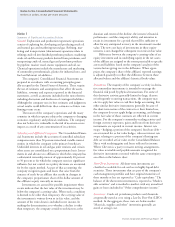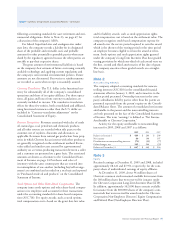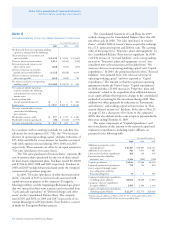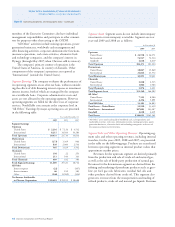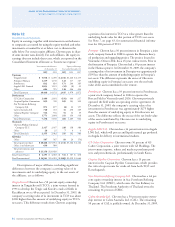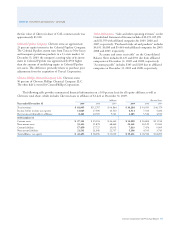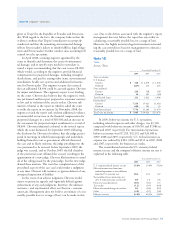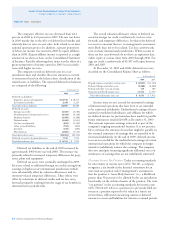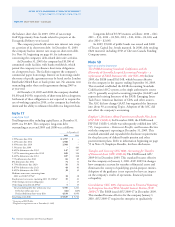Chevron 2009 Annual Report Download - page 49
Download and view the complete annual report
Please find page 49 of the 2009 Chevron annual report below. You can navigate through the pages in the report by either clicking on the pages listed below, or by using the keyword search tool below to find specific information within the annual report.
Chevron Corporation 2009 Annual Report 47
FS-PB
Consolidated Statement of Income:
The Effect of Derivatives Not Designated as Hedging Instruments
Gain/(Loss)
Type of Derivative Statement of Year Ended December 31
Contract Income Classification 2009 2008
Foreign Exchange Other income $ 26 $ (314)
Commodity Sales and other
operating revenues (94) 706
Commodity Purchased crude oil
and products (353) 424
Commodity Other income – (3)
$ (421) $ 813
Foreign Currency The company may enter into currency
derivative contracts to manage some of its foreign currency
exposures. These exposures include revenue and anticipated
purchase transactions, including foreign currency capital
expenditures and lease commitments. The currency deriva-
tive contracts, if any, are recorded at fair value on the balance
sheet with resulting gains and losses reflected in income.
There were no open currency derivative contracts at Decem-
ber 31, 2009.
Interest Rates The company may enter into interest rate swaps
from time to time as part of its overall strategy to manage the
interest rate risk on its debt. Historically, under the terms of
the swaps, net cash settlements were based on the difference
between fixed-rate and floating-rate interest amounts calcu-
lated by reference to agreed notional principal amounts.
Interest rate swaps related to a portion of the company’s fixed-
rate debt, if any, may be accounted for as fair value hedges.
Interest rate swaps related to floating-rate debt, if any, are
recorded at fair value on the balance sheet with resulting gains
and losses reflected in income. At year-end 2009, the com-
pany had no interest rate swaps. The company’s only interest
rate swaps on fixed-rate debt matured in January 2009.
Concentrations of Credit Risk The company’s financial instru-
ments that are exposed to concentrations of credit risk consist
primarily of its cash equivalents, marketable securities,
derivative financial instruments and trade receivables. The
company’s short-term investments are placed with a wide
array of financial institutions with high credit ratings. This
diversified investment policy limits the company’s exposure
both to credit risk and to concentrations of credit risk. Similar
standards of diversity and creditworthiness are applied to the
company’s counterparties in derivative instruments.
The trade receivable balances, reflecting the company’s
diver sified sources of revenue, are dispersed among the
company’s broad customer base worldwide. As a result, the
company believes concentrations of credit risk are limited.
The company routinely assesses the financial strength of its
customers. When the financial strength of a customer is not
considered sufficient, requiring Letters of Credit is a principal
method used to support sales to customers.
Note 11
Operating Segments and Geographic Data
Although each subsidiary of Chevron is responsible for its
own affairs, Chevron Corporation manages its investments
in these subsidiaries and their affiliates. For this purpose,
the investments are grouped as follows: upstream – explora-
tion and production; downstream – refining, marketing and
transportation; chemicals; and all other. The first three of these
groupings represent the company’s “reportable segments” and
“operating segments” as defined in accounting standards for
segment reporting (ASC 280).
The segments are separately managed for investment
purposes under a structure that includes “segment managers”
who report to the company’s “chief operating decision maker”
(CODM) (terms as defined in ASC 280). The CODM is
the company’s Executive Committee, a committee of senior
officers that includes the Chief Executive Officer and that, in
turn, reports to the Board of Directors of Chevron Corporation.
The operating segments represent components of the
company, as described in accounting standards for segment
reporting (ASC 280), that engage in activities (a) from which
revenues are earned and expenses are incurred; (b) whose
operating results are regularly reviewed by the CODM,
which makes decisions about resources to be allocated to the
segments and to assess their performance; and (c) for which
discrete financial information is available.
Segment managers for the reportable segments are
directly accountable to and maintain regular contact with the
company’s CODM to discuss the segment’s operating activities
and financial performance. The CODM approves annual
capital and exploratory budgets at the reportable segment level,
as well as reviews capital and exploratory funding for major
projects and approves major changes to the annual capital and
exploratory budgets. However, business-unit managers within
the operating segments are directly responsible for decisions
relating to project implementation and all other matters con-
nected with daily operations. Company officers who are
Note 10 Financial and Derivative Instruments – Continued




